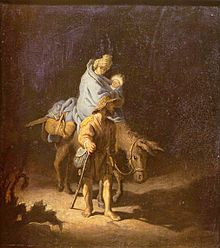Ach Gott, wie manches Herzeleid, BWV 58
|
Ach Gott, wie manches Herzeleid BWV 58 |
|
|---|---|
|
|

|
|
| Occasion | Sunday after New Year's Day |
| Performed | 5 January 1727: Leipzig |
| Movements | 5 |
| Cantata text | Christoph Birkmann |
| Chorale |
|
| Vocal | |
| Instrumental |
|
Ach Gott, wie manches Herzeleid (Ah God, how much heartbreak),BWV 58, is a church cantata by Johann Sebastian Bach. He composed the dialogue cantata in Leipzig for the Sunday after New Year's Day.
The text has been attributed to Christoph Birkmann by Christine Blanken of the Bach-Archiv Leipzig. He combined the topics of the readings, the gospel of the Flight into Egypt and teaching about the suffering of Christians from the First Epistle of Peter, in a structure of unusual symmetry with a duet as the first and last of the five movements. Both duets are dialogues of the Soul, represented by a soprano, and Jesus, sung by a bass as the vox Christi (voice of Christ). Both duets are set as a chorale fantasia, combining a stanza from a hymn, sung by the soprano as the cantus firmus, with original poetry set in counterpoint. Both stanzas are sung to the same melody, but come from different hymns, Martin Moller's "Ach Gott, wie manches Herzeleid", and Martin Behm's "Herr Jesu Christ, meins Lebens Licht". While the poet wrote the duets to fit the same music, Bach composed them in contrast, even changing the meter of the tune, to fit the different mood: lamenting heartbreak in the beginning, comfort in the end.
Bach scored the work for a small Baroque instrumental ensemble of originally just strings and continuo, probably intended to ease the workload of musicians for the Christmas season. In a later version, he added a trio of oboes to the outer movements. Bach counted the work as part of his cycle of chorale cantatas, which he had begun in 1724. It was presumably first performed on 5 January 1727.
...
Wikipedia
